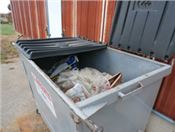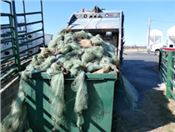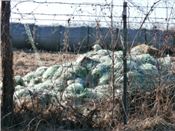Plastic Used To Wrap Hay Bales Poses Farm Dilemma
MT. VERNON, MO.
Most everyone in the livestock business agrees that using plastic for baled forage is a great tool that benefits both the farmer and livestock. However, proper disposal of the plastic after it has been used on hay is a major obstacle and problem according to Eldon Cole, livestock specialist for University of Missouri Extension.
“Southwest Missouri farmers have used plastics to protect baled forages for many years. It started in the form of twine before moving to cape-like plastic sheets, then bags that totally covered bales (except the ends) and then net wrapping became popular,” said Cole.
Plastic can be a great asset by preserving hay stored outside, speeding up baling and allowing high moisture haylage to be made.
“Haylage found more extensive adoption in 2015 as it allowed farmers to harvest hay with minimal worry about approaching rain events,” said Cole. “With all those positive points, it is unfortunate that there is, at least, one concern of major proportion.”
Cole says the major drawback is the proper disposal of the plastic after it has served its purpose. Burning is not acceptable from an environmental standpoint.
“During the hay feeding season you almost feel the approved disposal method of forage plastics is to place them on the back of the truck and drive down the road and let them find their final resting place wherever they land,” said Cole.
A lot of plastic is burned, sent to a landfill or thrown in abandoned wells or ditches.
There are recyclers of agriculture-related plastics, but most of them do not accept plastics used for silage, haylage or hay. Their usual response is, “it is too dirty and expensive to clean up.”
“There are a few however that will take it, and one use I’ve read about is to convert it into non-concrete sidewalk pavers,” said Cole.
The first challenge is to gather up the plastic wraps from the vast number of farms, so you have a sufficient amount to ship or process. Some communities in the eastern part of the United States offer collection points where the plastic is compacted into bales suitable for shipping.
Collection points with dumpsters could be a workable idea. Those points might be located where farmers gather. Places like coffee shops, feed and farm supply stores and sale barns.
“Some even suggest companies that sell the material should offer that disposal service to customers – perhaps for a small fee – like tire shops charge for used tires,” said Cole. “In the meantime, farmers who use plastics in their forage handling should do their best not to allow the plastic wrapping to litter the roadside and fields.” ∆

One attempt to collect net wrap in a dumpster and send to landfill.
Photos credit: MU Extension

Net wrap headed to a landfill.

A pile of net wrap in fence row.